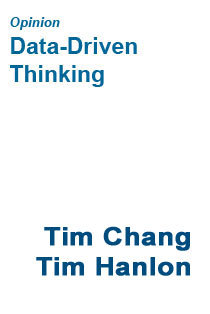 “Data-Driven Thinking” is a column written by members of the media community and containing fresh ideas on the digital revolution in media.
“Data-Driven Thinking” is a column written by members of the media community and containing fresh ideas on the digital revolution in media.
Today’s column is written by Tim Chang, Managing Director, Mayfield Fund, a venture investment firm, and Tim Hanlon, CEO, Vertere Group, a consulting group.
The brand ad market is massive (multi-multi $B), with 67% of worldwide ad spend in branding.
However only 25% of digital ad spend is in branding and the online brand ad market is still relatively primitive for these reasons:
- No standards or consistent measures of “success” other than outdated or inadequate metrics like CPM and CTR (clickthrough rate)
- Limited real-time intelligence
- Unsuitable display ad formats (still mostly banners)
- Lack of creativity in formats
Today, marketers and their agencies are overwhelmed by media choices, and departments are not optimized for a data-driven future of real-time bidding in the digital world. Online advertising is driving the need for a new breed of marketer who can handle an exponential blizzard of data sets (external and proprietary) and derive actionable marketing insights/decisions. As a result, CMOs and CIOs are cross-pollinating, driven by CRM/loyalty programs tied to increasingly granular media measures.
However, some in the ad industry lament that the awkward growth of the online display market is pushing things too far into the “math men” camp, and a “correction” of sorts is overdue, especially as some of the data measurement tenets start to come to other media forms – this drives a real need for an “informed” brand metric (e.g. brand metrics “2.0”). This new era of “big data” is not ready to fully replace traditional metrics from “tiny data” such as Nielsen-like TV sampling projections (e.g. national ratings based on sampling only 40k homes), but is primed to supplement and enhance traditional measures. A good analogy is what has happened in investment bank ratings: S&P, Fitch, and Moody’s legacy ratings are now quickly supplemented with multiple sources of granular data, ending sole reliance on proprietary incumbent systems, and adding more depth and sophistication of understanding.
The current world of online advertising is effectively dominated by the single metric of click-through rate as the key measurement of ad effectiveness. However, clicks are not an effective measure of online advertising effectiveness, as even effective online branding and display ads do not naturally lead to click-through like eCommerce-oriented direct response ads do. The predominant CPM-based approach has been driven by legacy TV formats centered upon static “impressions” and do not capture the interactivity and complexity of today’s digital formats. The ad tech industry is evolving new approaches to media expenditures – including what industry leaders are calling a “Brand Equity Index,” which aims to equate and more accurately depict the actual contribution and effectiveness of various forms of “media” expenditures against brands and consumers.
To support these new approaches, today’s brand marketers, publisher ad sales teams, and agencies have very few tools to understand their online brand equity – the ad tech market has not yet had simple Google Analytics or Omniture-style SaaS solutions, or even Google Search-style tools to dynamically lookup or index online ad performance and metrics. We believe this void presents a dramatic opportunity for a hybrid agency/SaaS company that combines the simplicity of Google Image Search, specialized tastes of Pinterest users and the back-end power of a Google Analytics on steroids. With the emergence of companies that deliver such solutions, ad tech can benefit from real brand intelligence and brand analytics, at the same level of granularity and depth that all other online businesses, from gaming to eCommerce to social media now enjoy.
Follow Tim Chang (@timchange), Tim Hanlon (@timhanlon), Mayfield Fund (@mayfieldfund), Vertere Group (@verteregroup) and AdExchanger (@adexchanger) on Twitter.











